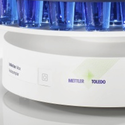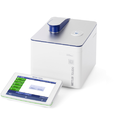This page describes the application of the UV Vis method for measuring copper concentrations in battery wastewater, highlighting its significance in environmental protection.
When you download this application package, you will receive a PDF of the application note as well as the required data for the LabX™ UV Vis spectrophotometry software method.
Why should you quantify copper in battery wastewater?
Copper is a prevalent contaminant in battery wastewater due to its extensive use in battery manufacturing and recycling processes. Its harmful effects on human health and the environment necessitate stringent monitoring and removal strategies.
How do you quantify copper content in battery wastewater spectrophotometrically?
The UV Vis method involves measuring the absorbance of light at specific wavelengths to determine the concentration of substances in a solution. In this application, cuprizone forms a blue-colored complex with copper(II) ions, then measured at 600 nm. This colorimetric approach allows for precise determinations of copper levels in wastewater samples.
Who can benefit from this application note?
This application note is valuable for:
- Environmental laboratories conducting wastewater analyses
- Industries involved in battery manufacturing and recycling
- Regulatory bodies monitoring compliance with environmental standards






